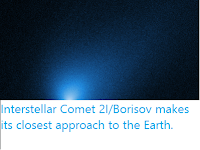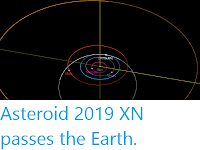Asteroid 2008 LW16 passed by the Earth at a distance of about 16 979 000
km (44.2 times the average distance between the Earth and the Moon, or 11.3% of the distance between the Earth and the Sun), slightly after 11.55 am
GMT on Saturday 4 January 2020. There was no danger of
the asteroid hitting us, though were it to do so it would have
presented a considerable threat. 2008 LW16 has an estimated
equivalent
diameter of 210-650 m (i.e. it is estimated that a spherical object with
the same volume would be 210-650 m in diameter), and an object of this
size would be predicted to be capable of passing through the Earth's
atmosphere relatively intact, impacting the ground directly with an
explosion that would be 17 500-800 000 times as powerful as the Hiroshima
bomb. Such an impact would result in an impact crater 3-9 km in diameter
and devastation on a global scale, as well as climatic effects that
would last decades or even centuries.
The calculated orbit of 2008 LW16. Minor Planet Center.
2008 LW16 was discovered on 15 June 2008 by the University of Arizona's Catalina Sky Survey,
which is located in the Catalina Mountains north of Tucson. The
designation 2008 LW16 implies that it was the 406th asteroid (object W16 -
in numbering asteroids the letters A-Y, excluding I, are assigned
numbers from 1 to 24, so that W16 = (24 x 16) + 22 = 406)
discovered in the first half of June 2008 (period 2008 W).
2008 LW16 has an 402 day orbital period and an eccentric orbit
tilted at an angle of 29.7° to the plane of the Solar System, which
takes it from 0.96 AU from the Sun (i.e. 96% of the the average distance
at
which the Earth orbits the Sun) to 1.18 AU from the Sun (i.e. 118% of
the
average distance at which the Earth orbits the Sun). It is therefore
classed as an
Apollo Group Asteroid (an asteroid that is on average further from the
Sun than the Earth, but which does get closer). This means that close
encounters between the asteroid and Earth are extremely common, with the
last having occurred in July last year (2019) and the next predicted
in June this year (2020). As an
asteroid probably larger than 150 m in diameter
that occasionally comes within 0.05 AU of the Earth, 2019 AV2 is also
classified as a Potentially Hazardous Asteroid.
See also...
Follow Sciency Thoughts on Facebook.







